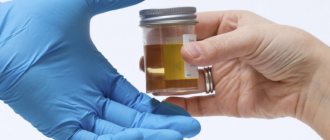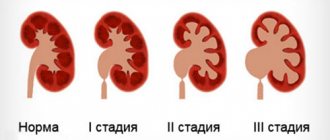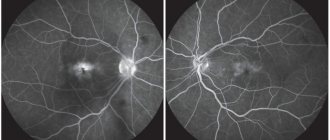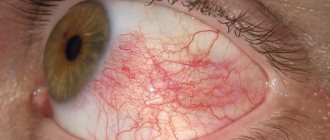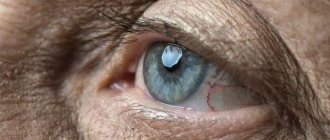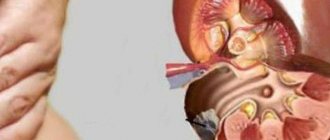Carrying out a large number of tests during pregnancy is necessary to identify possible diseases that pose a threat to the unborn child. Thanks to regular examinations, it is possible to identify hidden diseases that women were not even aware of. One of the most dangerous diseases is cerebral palsy (CP). Unfortunately, identifying cerebral palsy during pregnancy in the early stages is impossible, but it is still possible to identify diseases that can trigger the development of this disease. The main cause of the development of the disease is pathological pregnancy.
Why can a child develop cerebral palsy during pregnancy?
There are many factors that can cause this illness in a child, and often it is not possible to identify the exact cause for each specific case. The disease develops both in utero and after the birth of the baby. The list of the most common causes of cerebral palsy in children includes the following conditions:
- disorders in the development of the cerebral cortex;
- fetal hypoxia;
- brain damage during childbirth;
- viral infections;
- conflict between the blood of the child and the mother, which causes jaundice;
- birth trauma;
- fetal poisoning.
Often the causes of the development of the disease are not prevented by doctors or the mother herself, especially if the disease develops against the background of chronic hypoxia.
Important! More often, the disease occurs when pregnancy is too early (before 18 years) or late (after 40 years), or if the mother has an addiction to tobacco products, alcohol or drugs.
Intrauterine causes of the development of cerebral palsy in a child
There are more than fifty factors that can provoke the development of cerebral palsy in a child during pregnancy. Most often, the disease occurs as a consequence of pathological childbirth, which is very difficult to control. Intrauterine development of the disease can occur due to the following factors:
- use of hormonal drugs in early pregnancy;
- genetic predisposition;
- infectious lesions of the placenta;
- oxygen starvation of the fetus with placental insufficiency.
It is not possible to determine the disease during pregnancy, but doctors diagnose other diseases that can further provoke the development of cerebral palsy.
What are the prerequisites for the development of cerebral palsy in a child?
Despite modern methods of research into the mechanism of development of cerebral palsy, the exact risk factors have not yet been determined. The development of such clinical syndromes can be caused by a variety of conditions, for example, incompatibility of the blood of mother and child or the presence of diseases such as rubella in a pregnant woman. Such abnormalities can be detected during a medical examination, so it is strongly recommended to visit a doctor regularly during pregnancy.
If a woman has chronic diseases, such as diabetes or anemia, it is necessary to adhere to a proper diet and provide timely medical care during the prenatal period.
Important! During a medical examination, special attention should be paid to the analysis of the RH factor. If the mother has a negative Rh factor and the child is positive, it is necessary to carry out immunization within seventy-two hours from the moment of birth to prevent possible consequences in subsequent pregnancies.
Cerebral palsy - what is it?
According to world statistics, cerebral palsy occurs with a frequency of 1.7 to 7 cases per 1000 children aged from birth to one year.
In the Russian Federation, according to various sources, this figure ranges from 2.5 to 6 cases per 1000 children. About 50% of patients were born with cerebral palsy as a result of premature birth. Classification of cerebral palsy
In neurology, taking into account the location of the affected area of the brain, five types of cerebral palsy are distinguished:
- Spastic diplegia. The most common form, occurs in 40-80% of the total number of cases. The disease develops due to damage to the motor centers, resulting in paresis (more pronounced in the lower extremities).
- Hemiparetic form of cerebral palsy. It is formed due to damage to the motor centers of only one hemisphere. It manifests itself as paresis of a leg or arm on the side opposite to the spread of the pathological process.
- Hyperkinetic form (25% of cases). Caused by damage to subcortical structures. Among its signs are involuntary movements (hyperkinesis), which intensify if the child is tired or nervous.
- Atonic-astatic form (10%). Occurs when there are disorders in the cerebellum. It is characterized by impaired coordination, statics, and muscle atony.
- Double hemiplegia. The most severe form of cerebral palsy in children. It is a consequence of complete damage to both hemispheres of the brain, leading to muscle rigidity. Patients cannot sit, stand, or even hold their head up on their own.
In clinical practice, there are also mixed variants of cerebral palsy, which are characterized by symptoms of several forms of the disease. Thus, very often spastic diplegia is combined with a hyperkinetic form.
Is it possible to detect cerebral palsy during pregnancy?
When a fetus develops cerebral palsy, there are no symptoms. Even in newborn children, the disease cannot be detected immediately, but after some time. Sometimes there are situations when a healthy child is injured during a pathological birth, which is why he develops a disease. If there are risk factors that can cause the development of this disease, a diagnosis should be made that will most likely be able to determine the presence or absence of the disease in the child.
Diagnosis during pregnancy
It is possible to eliminate the causes of the disease after carrying out such diagnostic measures as ultrasound, auscultation, cardiotocography, non-stress test, Doppler testing and electrocardiography. Unfortunately, all these methods of comprehensive diagnosis of a woman do not guarantee 100% exclusion of the disease. Even a newborn examination cannot confirm the diagnosis. The child’s development should be monitored and a study of the child should begin when the first alarming symptoms appear.
How is cerebral palsy diagnosed during pregnancy?
If there is a suspicion of the development of cerebral palsy, diagnosis in pregnant women involves a number of specific studies:
- computed tomography (CT);
- magnetic resonance imaging (MRI);
- radiology diagnostics;
- echoencephalogram;
- electromyography;
- neurosonogathia.
These studies are aimed at studying the fetal brain to identify abnormalities in its functioning. If the diagnosis of cerebral palsy is confirmed, parents should prepare to raise a child with cerebral palsy. Such children retain sixty percent of their mental abilities, while forty percent of children with cerebral palsy lag behind their peers and differ in behavior.
List of studies that help doctors make a diagnosis
Most types of research are carried out after the birth of the child at different stages of his development and life. These studies include:
- Echoencephalography is an ultrasound diagnostic method based on the principle of echolocation. This test can be carried out from birth. In a number of diseases of the central nervous system, it helps to identify the expansion of the ventricles of the brain and the asymmetry of its hemispheres.
- Neurosonography can be performed as long as the size of the large fontanelle allows. This ultrasound diagnostic method allows you to clarify the structure of the brain and determine the size of its ventricles.
- Electroencephalography (EEG) is a method for studying brain activity, based on recording the bioelectrical activity of individual zones, regions, and lobes of the brain. In some specialized clinics, this study is carried out from 6-7 months of life, and, if necessary, earlier. With cerebral palsy, pronounced age-related immaturity of the brain and some other conditions are revealed.
- Computed tomography (CT) and nuclear magnetic resonance (NMR) are the most informative methods available today. CT is a radiation diagnostic method that allows you to obtain a series of cross-sectional images of almost any part of the human body. NMR is a method based on resonant absorption of radio waves. It allows you to obtain two-dimensional images of the organ under study in any section and convert them into three-dimensional images. CT and NMR show defects in brain development, clarifying the picture of existing disorders.
- Electromyography is a fairly common method that studies the electrical activity of muscles. It should be recognized that it is not very informative from the point of view of diagnosing cerebral palsy and is carried out in later periods of the child’s life.
- Neurosonography is a method that allows you to clarify the structure and anomalies of the brain, the size of the ventricles and hemispheres.
And always remember: cerebral palsy is not a death sentence. On our website we tell stories of people who have proven this in practice.
Methods for preventing cerebral palsy
Just like most other diseases, the main way to prevent it is to lead a healthy lifestyle. First of all, you need to give up bad habits (smoking, alcoholism, etc.), and before planning a pregnancy, undergo a full medical examination to eliminate the risk of chronic diseases. If a pregnant woman has viral or bacterial diseases, it is necessary to treat them in the second trimester, when medications no longer have such a detrimental effect on the child.
During pregnancy, it is important to regularly monitor hemoglobin levels and other health indicators. Throughout pregnancy, it is important to protect yourself from diseases such as acute respiratory viral infections, influenza, herpes, and other infections, as well as protect yourself from chemical or radioactive exposure.
During pregnancy, a woman may experience a variety of changes in her body, but such disorders do not always cause the development of cerebral palsy in the child. The natural mechanisms of protection of the fetus protect the baby from negative influences for a certain time. It is important to immediately seek medical help if any prerequisites for illness arise.
Does MRI show cerebral palsy?
The human brain is 70-90% water, which is why it is considered an ideal object for magnetic resonance imaging. Among all methods for detecting cerebral palsy, MRI can be called the most reliable. The examination allows you to see lesions of the white and gray matter and hidden structural changes (especially in the subcortical region and brainstem), which CT and ultrasound will not show. Thanks to the information obtained, specialists can develop an optimal treatment strategy, monitor the effectiveness of the measures taken and predict the outcome of the disease. In some cases, prenatal magnetic tomography is performed according to indications: certain abnormalities in the fetal brain are noticeable from 18-20 weeks of pregnancy.
MR images in axial projection (on the left in T2 mode, on the right FLAIR) visualize a picture of megalencephalic leukoencephalopathy with a subcortical cyst in the anterior left parietal lobe (red arrow).
What is cerebral palsy?
Cerebral palsy (CP) is a disease of motor functions characterized by the appearance as a result of injury to various parts of the brain in the perinatal stage. Experts include the most obvious signs of this disease as the presence of various forms of paralysis, abnormal deformations of muscle elasticity, problems with the speech apparatus, difficulties in coordinating motor properties, and retardation in physical and mental development in children.
In addition, such a disease provokes intellectual impairment, epileptic seizures, and an imbalance in the functioning of the visual and auditory areas. To identify the described pathological process, experts resort to the study of clinical indicators and anamnestic information.

